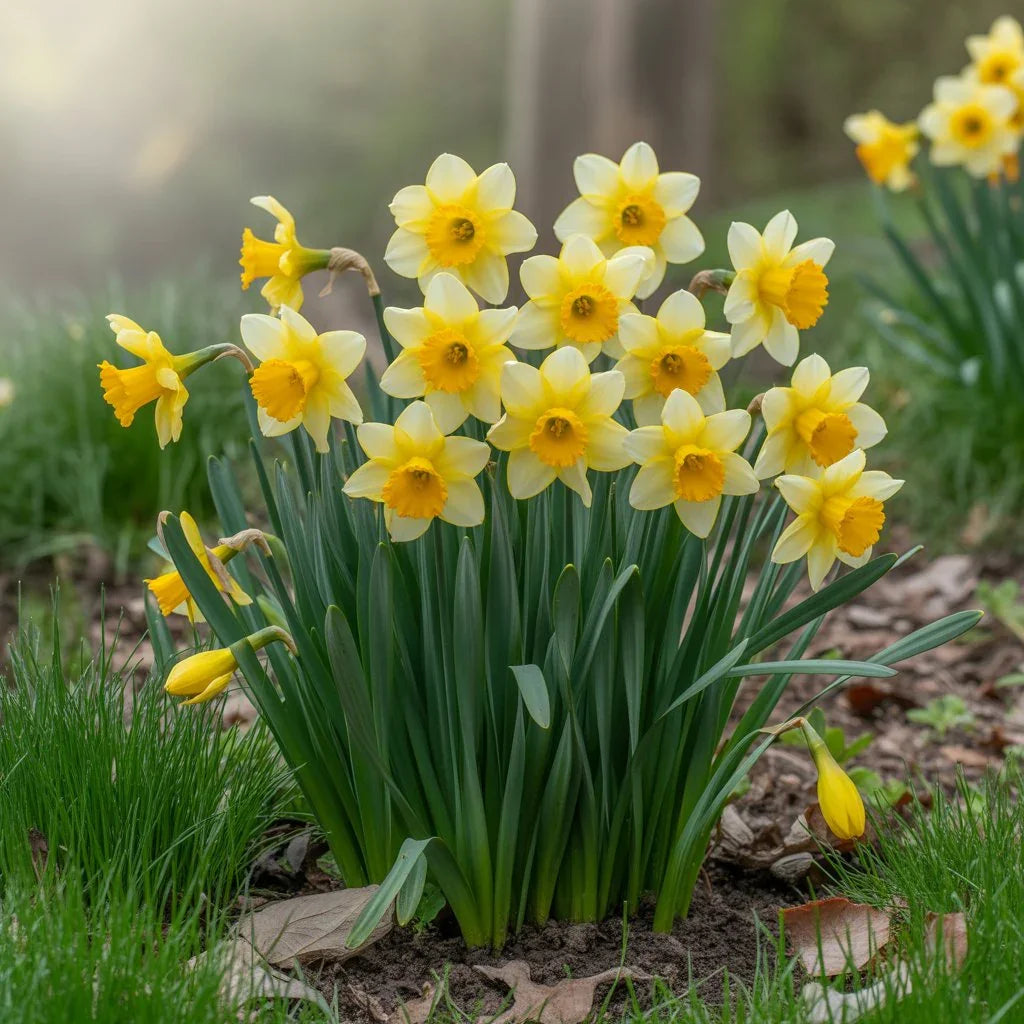
How to Plant Daffodil Bulbs: A Comprehensive Daffodil Plant Guide
Share
Daffodils, with their cheerful yellow hues, are a welcome sign of spring. This guide provides a complete overview on how to successfully plant daffodils and nurture them for vibrant blooms. It will cover key areas, including:
- Understanding the characteristics of daffodil bulbs
- Mastering the art of planting daffodil bulbs
With these essential tips and tricks, you'll transform your garden into a springtime paradise.
Understanding Daffodil Bulbs
Before embarking on planting daffodils, it's crucial to understand the nature of daffodil bulbs. A daffodil bulb is a storage structure, packed with the nutrient reserves required for the plant to grow and flower. These fascinating structures are essential for the perennial nature of these beloved flowers, enabling them to reappear year after year, bringing joy with their beautiful blooms. Knowing what to expect is a significant advantage.
What are Daffodil Bulbs?
Daffodil bulbs, also known by their botanical name narcissus, are essentially underground storage units for the plant. These bulbs contain all the necessary components for the plant to grow and bloom, including the developing flower, leaves, and root system. The bulb acts as a powerhouse, providing energy for the plant to emerge from the soil and produce those iconic daffodil flowers. It's important to handle them with care, ensuring you do not damage them before planting.
Types of Daffodil Bulbs
The world of daffodils is incredibly diverse, encompassing a wide variety of shapes, sizes, and colors. Different varieties of daffodil bulbs exist, from the classic trumpet daffodils to the charming miniature types and the double-flowered cultivars. Each variety possesses unique characteristics, influencing bloom time, flower size, and overall plant height. Exploring the various types allows you to curate a stunning display of spring color, perfectly suited to your garden's aesthetic.
Benefits of Planting Daffodil Bulbs
Planting daffodil bulbs is advantageous for several reasons. These bulbs are known for being easy to take care of, but they offer other benefits as well, including:
- Daffodils are relatively low-maintenance plants.
- They are deer-resistant.
Furthermore, daffodils naturalize readily, meaning they will multiply and spread over time, creating an even more spectacular display of spring color year after year, ensuring a lasting impact on your landscape.
Preparing to Plant Daffodils
Choosing the Right Soil for Daffodils
Selecting the appropriate soil is paramount when you plant daffodils. Daffodil bulbs thrive in well-draining soil that is rich in organic matter. Improve drainage by incorporating compost or other organic amendments. The ideal soil should retain moisture while allowing excess water to drain away, preventing bulb rot and fostering healthy root development. Prioritize a soil mix that supports robust growth and abundant, beautiful blooms. This ensures the plant has the necessary nutrients.
Best Time to Plant Daffodil Bulbs
The best time to plant daffodil bulbs is in the fall, typically from late September to November, depending on your climate zone. Planting during this period allows the plant to establish roots before the ground freezes, preparing them for vigorous growth and flowering in the spring. Soil temperature should ideally be below 60°F (15°C). Proper timing is crucial for the plant to flourish and show off their daffodil flowers when spring arrives.
Tools Needed for Planting Daffodils
To efficiently plant daffodils, gather essential tools. You'll need a few things to make the job easier, including:
- A garden trowel or bulb planter for digging holes.
- A sturdy shovel for amending the soil.
- Gardening gloves to protect your hands.
- A measuring tool to ensure proper depth and spacing.
- An auger for faster digging, especially when planting many bulbs.
Ensure you have everything ready to make planting daffodil bulbs a breeze.
Steps for Planting Daffodil Bulbs
How to Plant Daffodil Bulbs
Planting daffodil bulbs involves a few simple steps. First, dig a hole that is appropriate to the size of the daffodil bulb. Place the bulbs with the pointy end facing up. Cover the bulb with soil, gently firming it around the bulb. Water thoroughly after planting to help settle the soil and initiate root growth. Following these steps will help ensure that the plant grows effectively. Make sure to handle the daffodil bulbs with care during planting.
Ideal Depth and Spacing for Daffodils
Depth and spacing are vital for successful planting and to see the beautiful blooms. A general rule of thumb for planting is to plant daffodil bulbs at a depth three times as deep as the bulb's height. For example, if a bulb is 2 inches tall, plant it 6 inches deep. Space the bulbs 3-6 inches apart to allow for adequate circulation and growth. Proper depth and spacing help prevent overcrowding and promote healthy development of the root system of the plant.
Using an Auger for Efficient Planting
An auger can significantly speed up the process of planting daffodil bulbs, especially when planting in large flower beds. Attach the auger to a drill and create holes for your bulbs at the correct depth and spacing. This method saves time and effort compared to digging each hole manually. Ensure that the auger is suitable for the size of the daffodil bulb and the type of soil in your garden. Using an auger is a smart way to efficiently plant daffodils and ensure a stunning spring display.
Caring for Your Daffodils
Watering and Fertilizing Daffodil Plants
Proper watering is key when you plant daffodils to ensure abundant beautiful blooms. During the active growing season, especially as the daffodil flowers emerge, regularly water the plant, keeping the soil consistently moist but not waterlogged. Use compost and choose well-draining soil for your flower bulbs. After the blooms fade, reduce watering, allowing the soil to dry out slightly. Fertilize in the fall and early spring with a bulb fertilizer that’s rich in essential nutrients to promote robust plant growth.
How to Grow Daffodils Indoors
You can successfully grow daffodils indoors by planting daffodil bulbs in containers filled with well-draining soil. Place the bulbs with the pointy end facing up, ensuring they are planted at a depth three times as deep as the bulb's height. Water thoroughly and provide a sunny spot. Start this process in late fall or early winter to enjoy indoor beautiful blooms in early spring. This is a great way to enjoy daffodil flowers even without a garden.
Pest and Disease Management for Daffodils
Daffodils are generally resistant to many pests and diseases, but it's wise to be vigilant. Good drainage is essential, as excessively wet soil can lead to bulb rot. If pests like snails or slugs appear, use organic methods to control them. Ensure proper air circulation around your daffodils to prevent fungal diseases. Regularly inspect your plants to address any issues early and maintain healthy daffodil bulbs.
Enjoying Your Daffodil Flowers
When to Expect Daffodil Blooms
The bloom time for daffodils depends on the plant variety and your climate zone. Typically, you can expect daffodil flowers to bloom in early to mid-spring. Planting bulbs with staggered bloom times can extend the flowering season. Monitor the weather; warm spells can encourage earlier blooms, while late frosts may delay them. Patience is key – the anticipation is part of the joy when you plant daffodils.
Tips for Extending the Blooming Period
To prolong the display of your daffodil flowers, plant bulbs in a location that receives morning sun and afternoon shade. Remove faded blooms promptly to prevent the plant from expending energy on seed production. Ensure consistent watering during the blooming period to keep the soil moist. Also, consider planting different daffodil bulb varieties with varying bloom times to create a succession of color in your garden.
Using Daffodils in Landscaping
Daffodils are incredibly versatile for landscaping. You can plant daffodils in flower beds, borders, or naturalized areas. They pair beautifully with other spring-blooming bulbs like tulips and hyacinths. Consider mass plantings for a dramatic effect, or intersperse them among perennials to add early-season color. Daffodils are also ideal for planting under trees or in areas where deer are a problem, as they are deer-resistant, ensuring your plant thrives.
